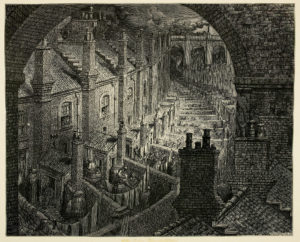Blog Post #5 – A Solemn Journey to London
February 19, 1893
I have almost completed packing for my move. I sometimes wonder if the decision I have made is the right one for me, but as I have now lost the last member of my family, I need a new beginning. London is that new beginning. It is only a two-hour journey into the city, but from this small town it feels like I’ll be entering a whole new world.
I have read Bradshaw’s Illustrated Handbook to London and its Environsin the past out of curiosity for the growing city, and have found that much of the information regarding the city has helped me prepare for my upcoming lifestyle. For clothing, I recall him writing this about the temperature, “The mean temperature is 52 degrees, and the extremes 81 degrees and 20 degrees; the former generally occurring in August, and the latter in January” (Bradshaw 17). Since I am moving in just a few days, I know to pack more clothes to bare the cold rather than the heat. I think that Bradshaw’s Handbookwill come in handy again soon, I will write further on the subject when it comes.
February 23, 1893
I am writing as we pull into King’s Cross Station and I do have to remark that Bradshaw’s Handbookwas right about the “London Fog” (17). It seems as though the view from my window is blurred, but I know it is not the glass, it’s the air. It feels almost warmer, but without the added heat, just a difference in the atmosphere.
The other stark contrast to my small town is the overwhelming amount of people on the platform. As we approach there is a sea of bodies, and I wonder how I will navigate through them all when I need to get off the train. In Bradshaw’s Handbookhe wrote about the growing population of London, “The number of houses is upwards of 298,000” (16). This number has most definitely risen since then as well. That idea overwhelms me, but I try to remain calm by noting that the more there are in the city, the more people I can begin good relationships with. Well, they just announced it’s time to exit the train, let my journey begin…

